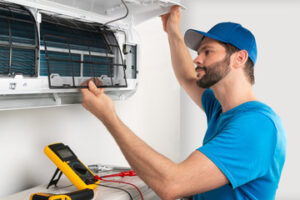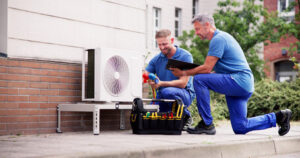HVAC is an all-encompassing term that refers to the systems and technologies that control indoor temperature and humidity. The HVAC system is made up of an air handler, blower fan, and a network of ducts that distribute conditioned air throughout the home.

The heating component of an HVAC system keeps interior spaces warm. It is also responsible for distributing the heat throughout the space, and removing humidity from it. Some HVAC systems combine the heating and air conditioning functions, while others have separate units for each. The resulting systems are capable of meeting many different indoor climate needs for homes and commercial buildings, including temperature control, ventilation, and air quality, but all of them rely on the same basic components. Visit proairconditioningrepairhendersonnv.com to learn more.
A blower fan circulates the heated air from the heat exchanger to your rooms through ductwork or into the room in a ductless system. A thermostat monitors the temperature, and when it reaches your desired setting, it signals the heater to turn off. The thermostat also has a sensor that can detect if any occupants are in the room and adjusts the heating accordingly.
Older thermostats use a bimetallic strip that has two exposed contacts. As the temperature drops, the element bends, allowing the contact arm to move close to the other contact, and close the circuit. This turns on the heater and the anticipator. The bimetallic strip uncoils as the temperature rises, breaking the second contact and keeping the heater turned off until the thermostat senses that the room is occupied again.
Newer thermostats have coiled bimetallic strips, with the contacts behind glass to protect them from dirt. When the temperature drops, a magnet moves down to a stationary steel bar and pulls up on a contact arm inside the coil. This opens the first contact and closes the second, turning on the heating system and the anticipator. The thermostat has a second sensor that detects when the room is occupied and switches the system from operation to energy savings mode.
The ventilation component of an HVAC system ensures that fresh air is constantly being brought in, and contaminated air is constantly being expelled. This helps maintain healthy interior temperatures and acceptable indoor air quality (IAQ), which is especially important in schools where the concentrations of both students and staff can be high. The ventilation system can also help to reduce noise levels by bringing in outside sounds, or by filtering out unwanted sounds from inside the building.
Cooling
Cooling is a key part of the heating, ventilation and air conditioning (HVAC) system. It keeps your home comfortable, and helps to keep the indoor air quality healthy and clean.
A cooling system works by removing heat from the air and blowing it back into the room through vents or ductwork. It can also remove humidity from the air, which will help to make your home feel more comfortable.
There are many different types of cooling systems, including central systems and window units. The type of system you have will depend on your needs and budget.
One of the most important parts of any HVAC system is the evaporator coil. This is where the refrigerant absorbs the heat from the air. It then moves to the compressor, where it is pressurized. This causes it to vaporize, which will cool the air that is sent through the ducts or vents.
During the cooling process, the refrigerant will also move to the condenser, where it will expel the heat from the space. This will cause the room to cool down, which is what we want in our homes.
Another part of the cooling process is a fan that will pull in fresh air from outside and distribute it throughout the room. This will help to lower the temperature in the room and also reduce the amount of energy used.
A good HVAC system will be able to save energy by using an economizer mode. This is a feature that will open the outdoor air damper and close the return air damper, which will allow outside air to be used to cool the building when it is cooler than the demand.
As technology continues to advance, the future of hvac is becoming increasingly intertwined with sustainability. RIGID is committed to pushing the boundaries of air-cooled chiller innovation, while maintaining a strong focus on environmental responsibility. By utilizing eco-friendly refrigerants and optimizing energy consumption, RIGID is setting the standard for the future of HVAC.
Ventilation
Ventilation is a key element of HVAC systems. It is the process of introducing clean outdoor air into a building or room and removing stale air, which can be accomplished by natural or mechanical means. Ventilation can improve indoor air quality by diluting pollutants and by reducing the concentration of contaminants (Etheridge & Sandberg, 1996).
In an average house, ventilation involves your air handler, ducts, return vents and blower assembly. These systems work in tandem to provide mechanical ventilation that reduces humidity levels and normalizes temperatures throughout your home. This is the big picture. Bad air gets pushed out, good air comes in and the AC or furnace takes care of temperature variables.
As for natural ventilation, it can occur in a variety of ways. For example, wind and buoyancy can move air from areas of high pressure to areas of low pressure. This occurs naturally in homes that have openings like windows and doors, but it can also be done with specially designed ventilators.
Most people are familiar with central systems, which involve ductwork that runs from an air handler to outlets throughout your home. These outlets are often positioned on walls, in ceilings or near floor registers. A split system operates similarly, except the evaporator coil is located in the air handler, while the condenser is outside. Refrigerant lines connect the two units and use refrigerant to transfer heat from the evaporator coil to the condenser. The condenser then transfers this heat to the air, which is then blown through ductwork and out vents around your home.
The location of the air intake for your HVAC system is important, especially if you live in an area with a lot of traffic and pollution. The intake should be as far away as possible from the exhaust outlets of nearby buildings, in order to avoid odors and pollutants migrating into your space. It is also important to locate the air intake away from moisture sources, such as basement garage floors and garbage collection points.
An HVAC technician is a tradesman who has been trained to install, repair and service HVAC equipment. Most technicians receive formal training in the form of an associate degree from a community college or technical school, and many have completed an apprenticeship with an experienced technician.
Thermostat
The thermostat is the part of your HVAC system that regulates how hot or cold your home is. It is usually installed on the wall, easy to reach and easily programmable for your preferences.
It works by sensing temperature through a built-in sensor and comparing it to your desired set point, which you choose on the unit itself. If it’s warmer than the thermostat setting, the system will activate cooling to bring the room back down to your preferred temperature. If it’s colder than your set point, the system will activate heating to warm up your home.
Older thermostats used a tube (similar to an old-style flash bulb) filled with mercury that would rock one way or the other depending on temperature changes and turn on or off two wires within the circuit board that powers your air conditioning system and furnace. Newer thermostats have sensors that measure temperature all the way down to 1/10th of a degree and use thermistors and other devices that close or open circuits to control your equipment.
Thermostats can also be programmable, which is useful for people with unpredictable schedules who want to make sure their home is comfortable. This will help to reduce your energy bills by allowing you to set a lower temperature during the day and a higher temperature at night.
Wifi-capable thermostats allow you to connect your device to your wifi, granting it internet access and allowing you to change settings from anywhere. Some thermostats will even monitor your usage, allowing you to see how much you’re spending on utilities, as well as alerting you when it’s time for maintenance or a system malfunction.
Thermostats can also be connected to smart home systems, which will let you control your heating and cooling remotely from any device that has an internet connection. Some will learn your unique HVAC habits and automatically adjust to maintain the best energy-efficient and comfortable settings. Smart thermostats can also grant your American Standard dealer remote diagnostic and monitoring access, so they’ll know how your system is performing before they come out to service it.
